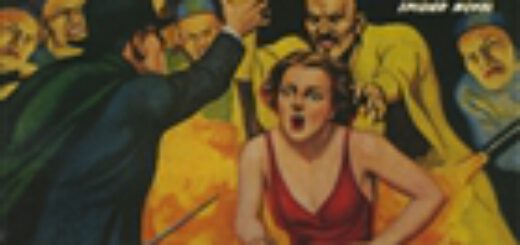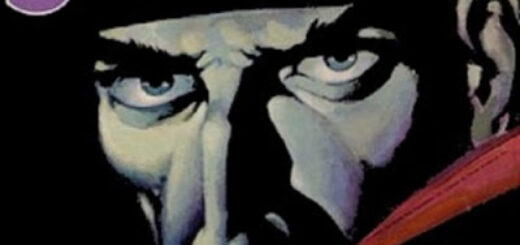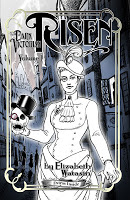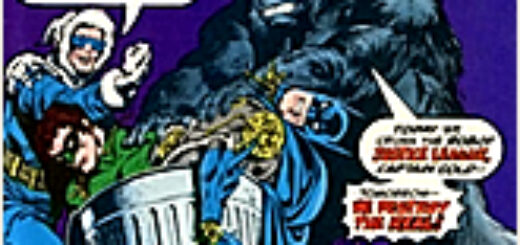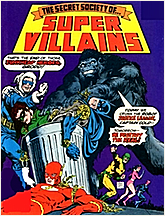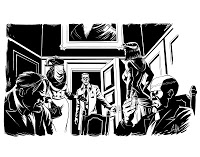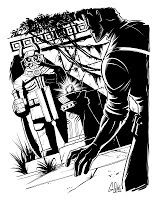Now Playing From Radio Archives

The origins of Jack “Flashgun” Casey can be traced to the 1930s detective pulp magazine “Black Mask”; the hard-boiled photojournalist was introduced in the March 1934 issue by former newspaperman/ad exec George Harmon Coxe. Coxe discussed the inspiration for Casey in a 1978 interview:
I had read and enjoyed the fiction exploits of reporters from time to time, but I also knew that it was the photographer accompanying such newsmen who frequently had to stick their neck out to get an acceptable picture. This is turn meant that while the reporter with his pad and pencil could describe a warehouse or dockside fire from a safe distance, the guy with the camera had to edge far closer to get a negative that would merit reproduction. So why not give the cameraman his due? If the reporter could be a glamorous figure in fiction, why not the guy up front who took – and still does take – the pictures?
So radio audiences received a formal introduction to Coxe’s creation over CBS Radio beginning July 7, 1943. The series was originally titled “Flashgun Casey,” but during its run it was also referred to as “Casey, Press Photographer,” “Crime Photographer.” and “Casey, Crime Photographer”. Casey snapped photos for the fictitious Morning Express, and often found himself cast in the role of amateur sleuth by getting involved in the stories he covered. Many of the plots had him stumbling across a clue in a photo he had taken (something the police had overlooked), and with the help of fellow reporter and romantic interest Annie Williams, they would inevitably bring the culprit(s) to justice.
What set “Casey, Crime Photographer” apart from its radio crime drama competition was its laid-back atmosphere, chiefly personified in its backdrop of Casey and Annie’s favorite dive, The Blue Note Café. There, in between assignments, they would engage in badinage with their philosophically sardonic bartender pal Ethelbert, often to the melodious accompaniment of the Blue Note’s background piano.
Matt Crowley was the first actor to tackle the role of Casey; replaced by Jim Backus and finally taken over by Staats Cotsworth, a radio veteran who also portrayed the title fourth-estate hero of NBC’s daytime serial “Front Page Farrell”. The part of Annie was essayed by many different actresses: Jone Allison, Alice Reinhart, Lesley Woods, Betty Furness, and Jan Miner were all heard at various times as the photographer’s main squeeze. Ethelbert was faithfully played by John Gibson throughout the entire run, and Captain Bill Logan – Casey and Annie’s contact on the police force – was portrayed by Jackson Beck and, later, Bernard Lenrow. The Blue Note’s pianist was played by Herman Chittison for most of Casey’s run, but Juan Hernandez and Teddy Wilson (formerly with the Benny Goodman Trio) were also on hand to tickle the ivories from time to time.
For most of the series’ run, “Casey, Crime Photographer” was sustained by CBS, except for brief periods of sponsorship by Anchor Hocking Glass (1946-48), Toni Home Permanents (1948-49), and Philip Morris Cigarettes (1949-50). The show’s association with Anchor Hocking is particularly noteworthy in that most of this series’ extant episodes were obtained from transcriptions saved by the glass company.
Noted inspirational author Dr. Norman Vincent Peale, King Haakon VII of Norway, Premier Gerbandy of the Netherlands, Premier Pierlot of Belgium, and US Senators Clark, Barkley, White, Hill and Congresswoman Clare Boothe Luce speak, as does the President of the United States, Franklin Delano Roosevelt. General Eisenhower speaks from SHAEF headquarters.


“The Great Gildersleeve” remains a favorite for old-time radio enthusiasts even today, as its fine writing, engaging characters and brilliant blend of comedy and drama sets a high watermark for classic situation comedy. You’ll be certain to enjoy the twenty original broadcasts offered in this collection, transferred directly from original 16” NBC Orthacoustic master recordings and presented exactly as broadcast, complete with commercials for Kraft Foods. 10 hours. Regular Price $29.98 – Specially priced until July 4 for $14.99 Audio CDs / $7.49 Download.


Two months ago James Waldorff had died and his body placed in the family vault. Now he walked again, a thing resurrected from the tomb! What was the secret of the strange curse that was turning one of America’s wealthiest houses into a family of living dead? The Secret 6 come out of hiding to tackle this weird mystery — and unravel the murder scheme of a corpse master! Criminals quaked at the name The Secret Six. And for four glorious issues, this team of six crimefighters took on some of the weirdest and most fantastic antagonists that ever reared their heads in the pulp magazines. It was where weird menace met six normal men with no strange gadgets or outlandish skills. The utterly amazing stories were written by Robert J. Hogan, better known for writing the G-8 and his Battle Aces stories. But after four issues, the over-the-top action came to an end and Popular Publications pulled the plug on the series. These vintage pulp tales are now reissued for today’s readers in electronic format. $2.99.
In 1934 a new type of magazine was born. Known by various names — the shudder pulps, mystery-terror magazines, horror-terror magazines — weird menace is the sub-genre term that has survived today. Dime Mystery Magazine was one of the most popular. It came from Popular Publications, whose publisher Harry Steeger was inspired by the Grand Guignol theater of Paris. This breed of pulp story survived less than ten years, but in that time, they became infamous, even to this day. This ebook contains a collection of stories from the pages of Dime Mystery Magazine, all written by Frederick C. Davis, reissued for today’s readers in electronic format. $2.99.




The Knight of Darkness proves that crime does not pay in two pulp classics by Walter B. Gibson writing as “Maxwell Grant.” First, The Shadow follows a trail of murder to retrieve the priceless rubies known as “The Seven Drops of Blood.” Then, to prove the innocence of a man accused of an impossible crime, the Dark Avenger must uncover the strange secret behind “Death from Nowhere.” BONUS: The Whisperer brings true sight to “The Eye of Zion” in a thriller by Alan Hathway writing as “Clifford Goodrich.” This instant collector’s item features the classic color pulp covers by Graves Gladney and George Rozen, the original interior illustrations by Tom Lovell and Edd Cartier, and commentary by popular culture historian Will Murray. $14.95.
The pulps’ original “Man of Steel” returns in three action-packed pulp thrillers by Paul Ernst and Emile Tepperman writing as “Kenneth Robeson.” First, smuggled “Pictures of Death” are only the sinister prelude to deadly sabotage and mass destruction. Then, Justice Inc. hunts for the antidote to a deadly malady that transforms men into apelike monstrosities in “The Green Killer.” Will the cure bring death to The Avenger? PLUS “Calling Justice Inc.,” a bonus Avenger thriller by Spider-scribe Emile Tepperman! This classic pulp reprint showcases the classic color pulp covers by Lenosci and William Timmons, Paul Orban’s interior illustrations and commentary by pulp historian Will Murray. $14.95.
The Man of Bronze and his daredevil cousin Pat Savage return in two classic pulp novels by Lester Dent and William Bogart writing as “Kenneth Robeson.” First, Doc Savage is accused of serial murders and jailed. Can Pat and Doc’s aides help unearth the strange secret of “The Invisible-Box Murders” and prove the Man of Bronze’s innocence? Then, Doc journeys to Honolulu after a strange letter makes Pat’s friend, Sally Trent, a “Target for Death.” BONUS: “The Hang String,” a rare 1933 tale by Lester Dent from the back pages of The Shadow Magazine. This double-novel collector’s edition leads off with a classic color cover by Emery Clarke, and showcases all of Paul Orban’s original interior illustrations and new historical commentary by Will Murray, writer of eleven Doc Savage novels. $14.95.



